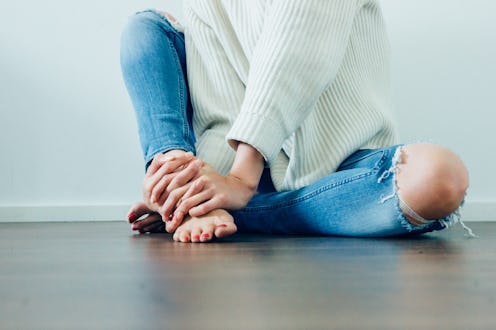
It's likely you've had your fair share of blisters in your lifetime — if you haven't, I want your blood tested for unicorn DNA. But, whether you're currently suffering or you're concerned about sandal season, you'll want to learn how to know if your blister is infected, because nobody wants an infection.
With other skin issues, such as cuts, it's easier to decipher when they're infected due to the fact that they fill up with an unfamiliar liquid. However, blisters appear pre-filled with their own juices, so it can be tricky to tell if yours is on the road to recovery or not. Blisters are often relentlessly sore. When they come into contact with just about anything, they make you flinch; much like when you're suffering from infected skin.
Dr. Sharyn Laughlin, board certified dermatologist at Laserderm and founder of Cyberderm, The Sunscreen Company, explains in an email to Bustle, "Blisters appear as a pocket of fluid just below the outer layer of skin or epidermis that result from trauma — either heat or a scald, sunburn, chemicals, or friction. They occur anywhere on the body but are more frequent on the hands and feet. A common cause is the friction from footwear rubbing on the skin over prominences on the foot." However, she adds that some skin diseases present with blisters too.
With all of this in mind, I spoke to Dr. Laughlin about how to know if your blister is infected.
What Does A "Healthy" Blister Look Like?
Before we get into the nitty-gritty of understanding the signs of an infected blister, it's important to know what a "healthy" blister looks like.
"The blister top forms a protective layer and the fluid within acts as a cushion that contains cellular and platelet factors, which further reduce damage to the underlying tissue and promotes healing, usually in 7-10 days. The fluid is usually clear or straw colored (serum) but may also be filled with blood," Dr. Laughlin tells Bustle over email. "The blister top keeps the fluid sterile and it is rare for the blister to become infected if it remains intact. The first and most crucial measure is to keep the blister top intact — do not pick at or remove it," she advises.
"If the blister is large you might use a darning needle or pin — sterilized with alcohol or heat — to make a small hole at the lower part of the blister that allows the fluid to drain. Do this only if necessary, as once the blister top layer has been breached by removal or pricking, the risk of infection increases. If the blister top is gone or open, a great covering is Duoderm Extra Thin burn dressing available over the counter (OTC) in the pharmacy. If unavailable to you, use a bandage that will only adhere to the surrounding normal skin and not the wounded area," Dr. Laughlin recommends. If this sounds like your blister, take a chill pill, your blister is likely not infected and there's no reason to panic.
Signs Of An Infected Blister
On the other hand, if your blister appears and/or feels different to the above description, it could be infected. Dr. Laughlin says, "Watch for tenderness or redness in the skin around the blister, or the fluid starting to look like pus. This indicates infection and a local crust may form. Apply an OTC antibiotic like Polysporin™ — or like Fucidin™, Bactroban™ (prescription only in some countries), under occlusion with an appropriate bandage. Change the antibiotic and dressing twice per day."
"If red streaks begin to radiate away from the blister or the surrounding skin becomes red, swollen and hot, if you experience fever or chills, this means a developing cellulitis. The latter two symptoms may also mean that the sepsis could be spreading to your blood and other systems. All of these are reasons to see your physician immediately, who may order blood tests, swab the blister, and prescribe antibiotics taken orally. With severe septicemia (infection of your blood), you could require hospitalization and intravenous antibiotics," warns Dr. Laughlin.
How To Prevent Traumatic Blisters
Dr. Laughlin informs me that traumatic blisters from sunburn, friction, or chemicals are best prevented with a couple of methods. To start, it's always best to wear the appropriate equipment, Dr. Laughlin explains that you should always wear gloves when handling chemicals and select the proper shoes for a given activity, "Avoid sandals for hiking or running — wear specific running shoes for the surface and type of activity, and footwear designed for each sport, court, and surface. Break in new shoes or work boots."
"For areas you know are prone to blisters," she elaborates, "use athletic tape, moleskin, Second Skin™, or a protective bandage. Wear fitted, moisture wicking socks for sports, running, and intensive gym training. For hiking or work boots, consider layering a thin sock within one that is slightly heavier to reduce friction even more."
Dr. Laughlin also highlights the importance of sunscreen, "Wear a good balanced sunscreen — preferably with clear zinc oxide > 20% on its own, or at least 15% with another particle type filter like titanium dioxide or encapsulated octinoxate at 5-7.5%. These achieve adequate SPF and UVA protection. Avoid soluble filters like oxybenzone, avobenzone and homosalate, octisalate, octocrylene etc. They reach blood from absorption through skin, give little UVA protection, and are all common photocontact allergens that may cause blistering in predisposed individuals, after repeated use and exposure to sunlight."
If you're in any doubt whatsoever about the condition of your blister, book an appointment with your dermatologist or doctor to put your mind at rest — better safe than sorry!
Images: Imani Clovis (1), Brina Blum (1), Tamara Menzi (1) /Unsplash